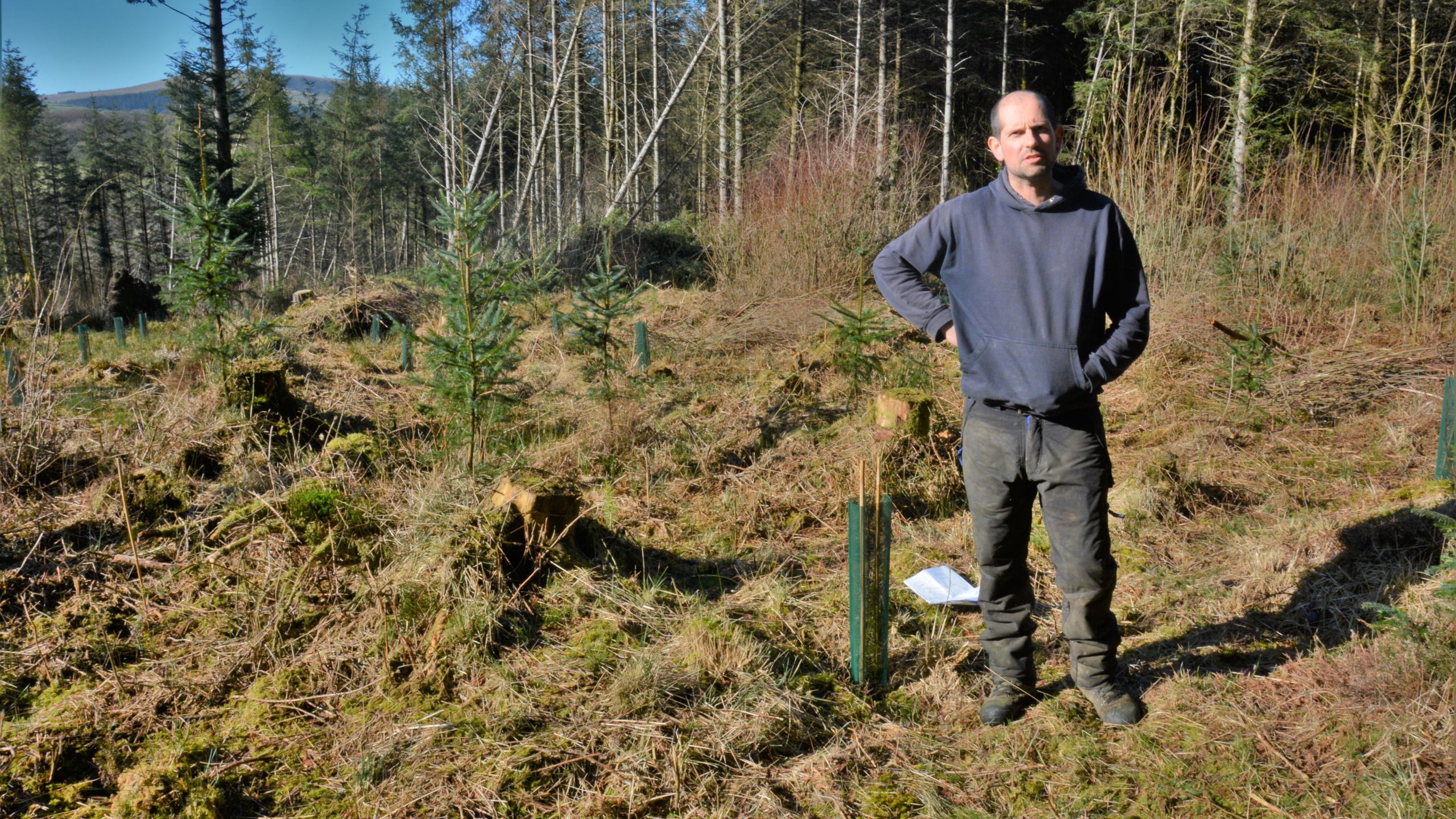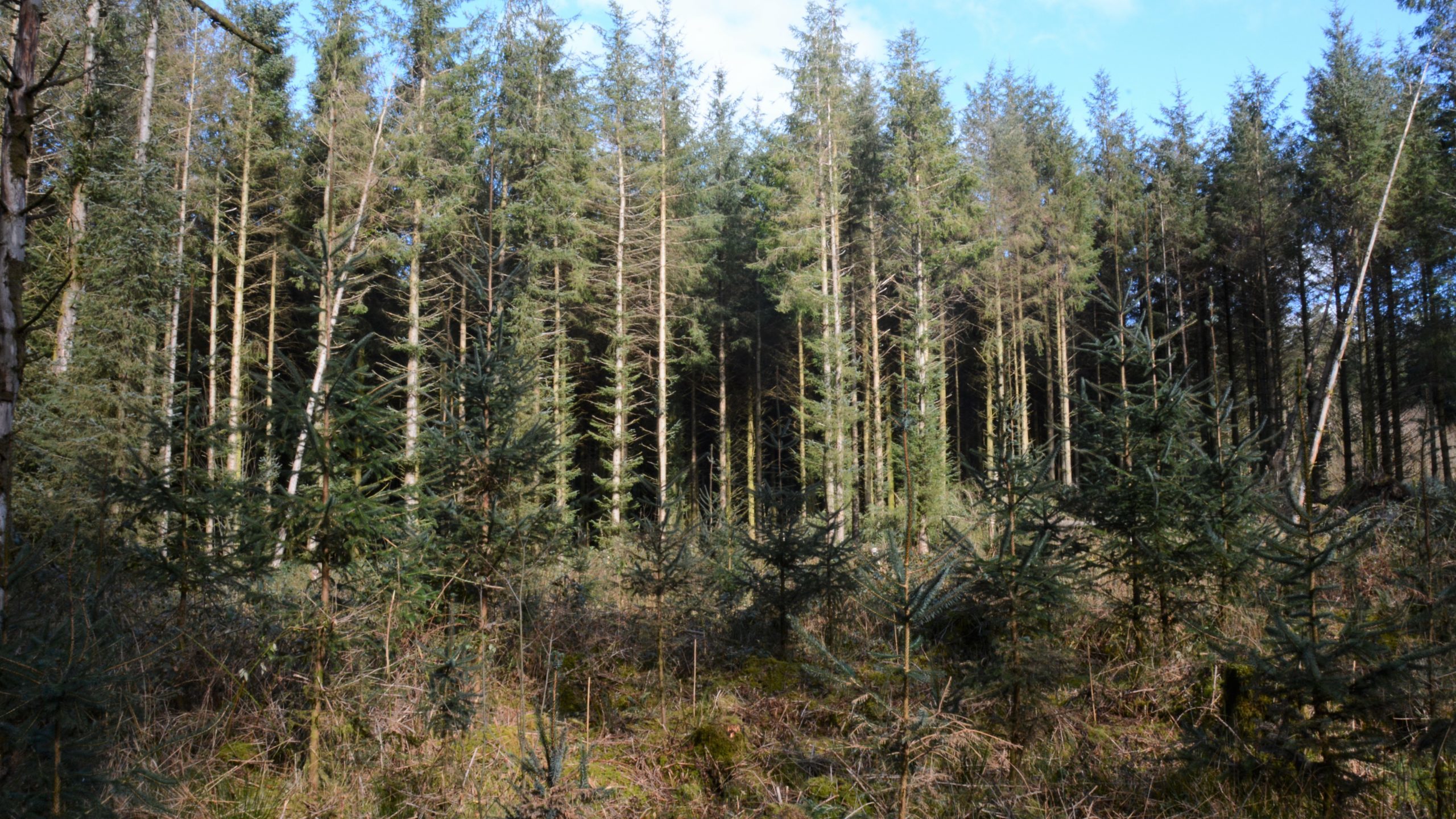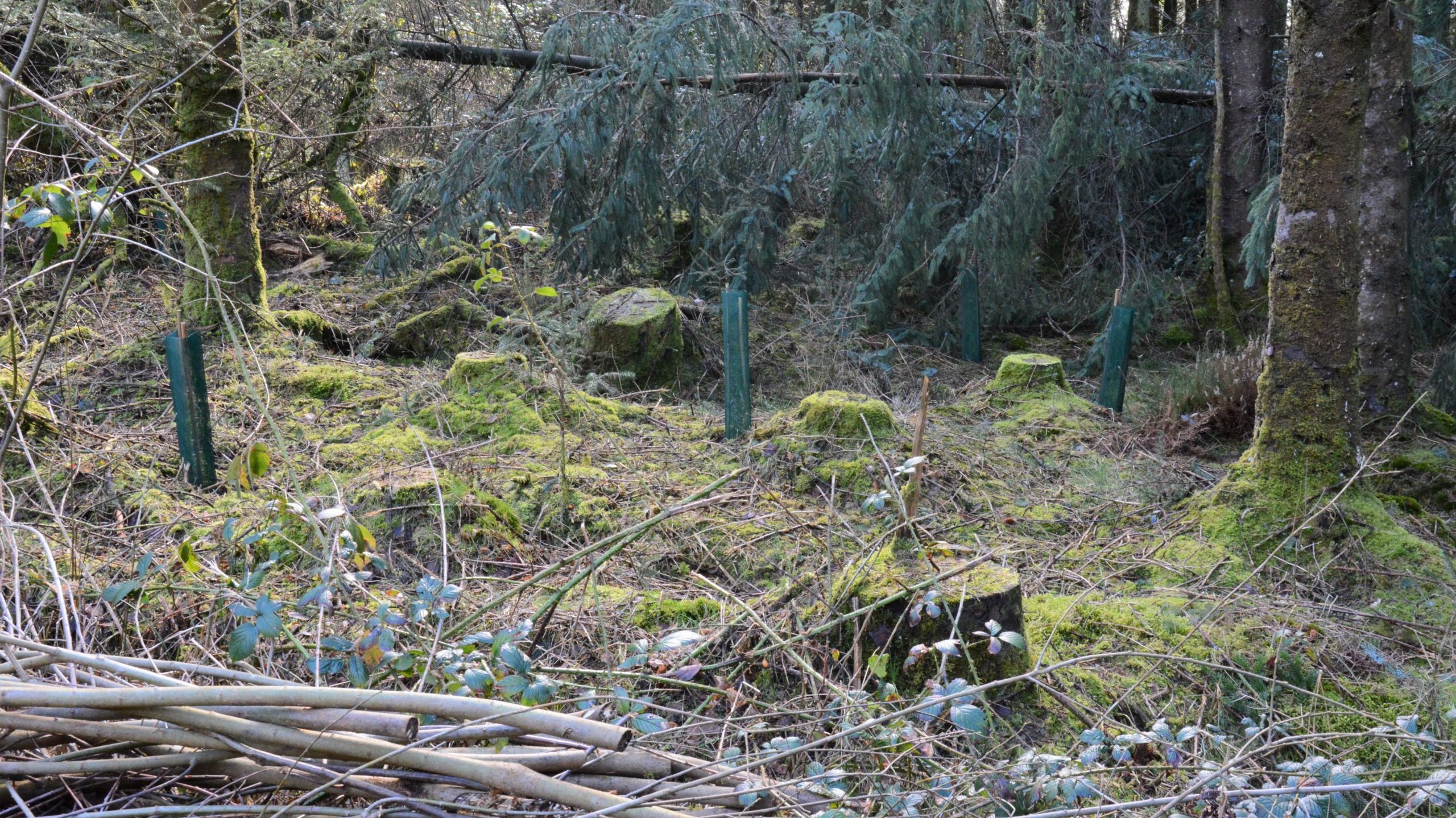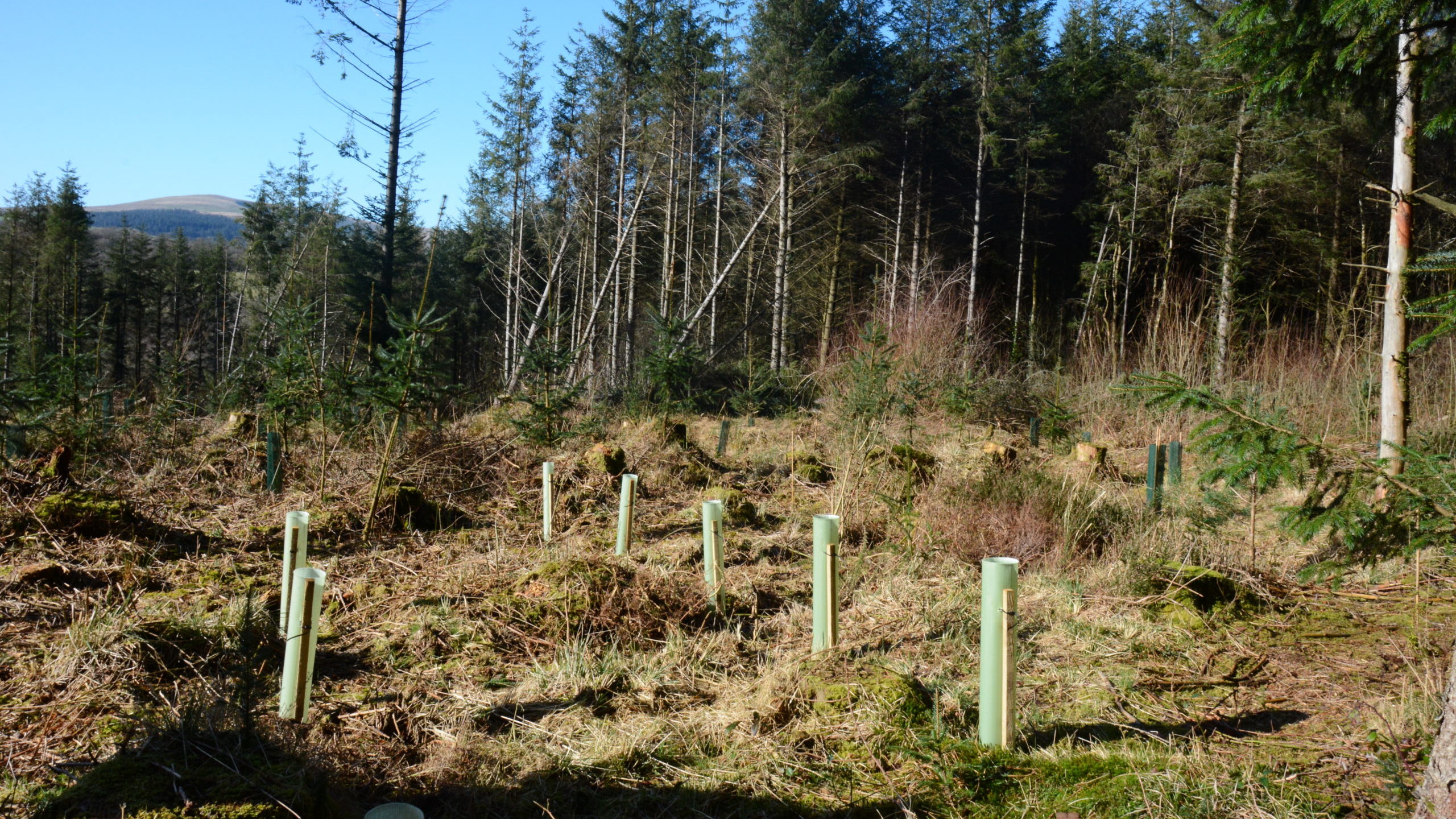Mosaic planting in windthrow woodland
Glandy Cross Wood, near Cardigan in West Wales, is a 38 hectare woodland bordering the Pembrokeshire National Park. It is in an area at medium risk of windthrow.
Owners Duncan Winton and his father Alan are transforming it from a Sitka spruce/larch plantation to continuous cover forestry.
Key points
- Windthrow has ‘punched’ areas of clearing
- Productive timber remains key management objective
- Phytophthora ramorum has impacted on larch which needs to be clearfelled
- A Resilient Woodlands and Treescapes grant has paid for enrichment planting in 3ha of recent windthrow clearings. the grants are funded by Train Hugger and GreenTheUK and are open to RFS and Royal Scottish Forestry Society (RSFS) members.
Background

Pictured above: Duncan Winton transforming Glandy Cross Wood
Duncan is a forest manager and forestry contractor specialising in establishment. He and his father bought Glandy Cross Wood in August 2020. The subsequent storms of Arwen, Dudley, Eunice and Franklin have all left their mark in small areas of windthrow.
The area had originally been rough grazing but is now predominantly fast-growing, thinned Sitka spruce. There are areas of Japanese larch, some lodgepole pine and a broadleaved scrub area. The largest compartment was planted in 1987 with other compartments planted in 1991, 1999 and 2005.
The wood lies on predominantly flat land, gently sloping to the north west at 140m to 200m above sea level. Part of the woodland falls within a Special Area of Conservation (SAC) and Site of Special Scientific Interest (SSSI). It is also bordered by the Cleddau Ddu river and the Preseli Hills of the Pembrokeshire National Park.
The land is typically wet with, very acid upland soils with a peaty surface over mudstone geology. Average rainfall exceeds 1,500mm a year.
The Windthrow Hazard Class has been estimated at 3, suggesting a medium risk.
An electricity wayleave crosses the site. There is no public access although a few local people walk their dogs and one nature enthusiast records wildlife.
Management objectives

Pictured above: Natural regeneration and enrichment planting in an area cleared after windthrow
The main aim is to grow trees for construction grade timber for the UK market while locking up carbon, increasing biodiversity and protecting evidence of Neolithic activity on the site.
By increasing species and moving towards a Continuous Cover Forestry (CCF) regime (with more species and structural diversity) the owners aim to reduce vulnerability of the woodland. This is particularly important in light of evidence-based predictions of increasingly extreme weather patterns caused by climate change, as well as increasing prevalence and numbers of pests and diseases.
Strong natural regeneration of Sitka spruce means this species is likely to remain a dominant species. Natural regeneration will be included within areas of mosaic planting with other timber species (conifers and broadleaves). This mosaic planting is being carried out:
- As larch affected by Phytophthora ramorum is felled (under a Glastir Woodland Restoration Grant)
- As windthrow opens areas for enrichment planting (underpinned by a Trainhugger and GreenTheUK Resilient Woodlands and Treescapes grant in 2021/22 in areas totalling 3ha)
- Where mature trees are selectively harvested
Windthrow
The wood is in an area where storms from the West and Southwest are expected. However, recent spring storms (some from unexpected directions) and an expected increase in extreme weather patterns have fed into management plans.
The owners feel that a diverse age and species structure will help spread and reduce the impact of wind and prepare the woodland to better withstand events in the future. They are using the opportunities provided by recent windthrow events to move the woodland away from single aged plantations. This will be supplemented by harvesting mature Sitka spruce, opening up additional areas for enrichment planting. Where larch has to be clear-felled (because of disease) the areas will also be planted up with a variety of species.
Species choice

Pictured above: Duncan is protecting every other Douglas fir to determine how frosts will impact on growth
Enrichment planting in areas funded by a Trainhugger and GreenTheUK Resilient Woodlands and Treescapes grant (2021/2022 planting season) include:
- Serbian spruce
- Norway spruce
- Western red cedar
- Japanese red cedar
- Douglas fir
- coast redwood
- small leaved lime
- wild cherry
- sweet chestnut
The Glastir Woodland Restoration grant will pay for restocking areas of larch that will be clear-felled this summer/autumn. In effect, this means that next season’s planting in areas of larch clear-fell will be the same species mix as in the windthrow pockets.
Choice of species has been guided by reference to:
- ‘The Silviculture of Trees Used in British Forestry’ by Peter Savill
- ‘The New Sylva’ by Gabriel Hemery
- the Silvifuture website
- Forest Research’s Ecological Site Classification DSS
- consultation with forester colleagues
- papers published in the QJF
Data was fed into the Ecological Site Classification (ESC) tool and the resulting report showed that some of the conifers chosen have “Marginal” or “Unsuitable” suitability for the site. The owners says the reality of Glandy Cross Wood is that, whilst much of the soil is peaty gley, very wet and even seasonally waterlogged, there are seams of better drained soil and some areas of brown earth. By carefully choosing different species for different planting sites, enrichment planting on patches of windthrow have so far shown this approach to species selection to be effective at achieving a good survival rate.
Planting

Pictured above: Broadleaves planted close to racks add biodiversity to the woodland
Planting density is no less than 2500/ha. Groups of around 50 cell grown trees are planted. The first 10 plants in each of the first five rows of the group are all of one species and then the species will change for the next 10 plants.
Serbian spruce (Picea omorika) has been planted more densely, because of its slender habit. The driest ground has been saved for Douglas fir (Pseudotsuga menziesii), Japanese red cedar (Cryptomeria japonica) and broadleaves.
Broadleaves are planted in the northwest of the site, close to existing racks (for added light as they grow).
Shade bearing Western red cedar, coast redwood and Japanese red cedar are being planted adjacent to advanced patches of Sitka spruce regeneration.
The 1,800 trees purchased with help from the Trainhugger and GreenTheUK Resilient Woodlands and Treescapes grant were all cell-grown by Cheviot Trees and notch planted. Although more cell-grown trees are more expensive than bare root trees, the increased flexibility on delivery availability enabled Duncan to plant during the early part of the 2021-2022 panting season, making use of ground that was still warm.
Management
For ease of maintenance every other plant is marked with a cane and broadleaved species are protected from rabbits by 0.6m tubes. There are no deer in the area and to date it has not been impacted by grey squirrels.
Shade bearing Western red cedar, coast redwood and Japanese red cedar are being planted close to areas of advanced Sitka spruce regeneration and up to 3m from existing crops.
With concern over the frost sensitivity of Douglas fir and Japanese red cedar, Duncan is protecting every other tree to see whether there will be a difference in growth between the protected and the unprotected.
All trees will be weeded twice in each growing season in the first 4 years (or until they are outcompeting surrounding vegetation); once in late April/early May; and second in mid/late August. Mechanical weeding is the first choice but herbicide will be used to spot spray if needed.
Formative pruning, particularly of the Japanese red cedar may begin within the first 10 years.
Harvesting
A good forest track had already been built within the wood and plans are to extend this to reach remoter areas where harvesting would be expected to start in the coming years.
Timber will usually be sold standing to achieve best prices.
Contact details: Duncan Winton: Tel, 07966 659810; email, duncan@treesandtimber.co.uk



